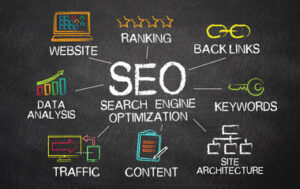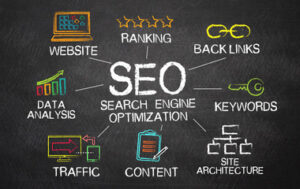Search engine optimization (SEO) is the process of optimizing a website to improve its search engine results pages (SERPs). It takes many factors into account, including keywords, content, backlinks, and analytics.

Keywords are the terms used by search engine users to discover content. Search engines, like Google, look for these terms in web pages and then index and display them according to their relevance to the search query. For this reason, keywords are a critical element of SEO and help to determine how your website is optimized.
Keyword research is one of the primary planning tools for SEO strategy and Content Marketing. It enables you to identify optimization opportunities and set your content creation priorities accordingly. The process starts by collecting all the keywords that relate to your product, brand or sector, and then assessing them for search volume and conversion potential. It also looks at how competitive the terms are, which is essential for setting content production goals.
Getting to know your audience is also crucial when it comes to selecting the right keywords for your site. For example, you can use the Ahrefs Keywords Explorer tool to find out what phrases your audience is searching for when they come to your site. You can then choose the ones that best match what you’re offering.
In order to ensure that your website’s content is properly optimized, it’s important to add the appropriate keywords in a natural way. You should include them in the title, the meta description, in the first paragraph and throughout the text of your webpage or post. However, don’t stuff keywords into your content or force them where they don’t make sense or aren’t adding value for your readers.
The keyword density of your website’s content is another factor that affects its search engine ranking. Generally speaking, the more keywords you use, the higher your page will rank, provided that they are relevant and that the quality of the content is high.
When choosing keywords, it’s also important to take into account the user intent behind each term. There are four commonly-recognized intents, including informational (i.e., research-related), navigational, commercial and transactional. This knowledge is useful when creating your content plan, as you can create pages that are specifically tailored to the needs of your target market.
Content
In SEO, content refers to any text, image or video on a website that can be indexed by search engines. It’s a crucial part of any successful SEO strategy and should not be skimped on. Content can be in the form of blog posts, landing pages, product descriptions or other static page content. It can also include infographics, videos and other multimedia content. The key is to produce quality content that matches what your target audience is searching for. Researching the keywords your audience is using can help you develop content that answers their questions.
Creating quality SEO content has many benefits for businesses. Not only does it help drive traffic to your website, but it can also help convert potential customers. High-ranking organic search results receive over 40% click-through rates, compared to only 2% for paid ads. In addition, high-quality SEO content builds credibility and trust for your business and can provide lasting value.
SEO content is online content that’s designed to rank in search engine results pages (SERPs). It’s typically optimized for a particular keyword, and it can be written in a variety of formats, including blog posts, news type articles, lists, how-to guides, press releases, and other static page content. In fact, HubSpot reports that companies that publish blogs on a regular basis get 350% more traffic than those that don’t.
Content plays a role in nearly every aspect of SEO, including keyword research, link building, on-page optimization and analytics. However, creating and optimizing SEO content requires a unique set of skills. It must be informative, relevant and useful to your target audience.
It should also be well-organized and easy to read. The use of h1, h2, and h3 headings can help structure the content and make it easier to scan. It’s also important to avoid keyword stuffing, which can have a negative impact on your SEO. Instead, incorporate your keyword naturally and strategically throughout the content.
Google’s mission is to “deliver useful and relevant results to searchers.” The kind of content that deserves to rank well doesn’t just optimize for search engines, but it also keeps the user’s experience in mind. That’s why implementing structured data in your content is so important.
Backlinks
Backlinks are a crucial aspect of SEO, and they’re one of the most important factors in how search engines rank pages. They’re links from external websites to pages on your own website that demonstrate the relevance of your page to a particular topic. Search engines like Google use bots (or spiders) to crawl the web from link to link, discovering content along the way. When a bot finds a relevant page, it will index the page and add it to its database.
The more quality backlinks you have, the better. However, not all backlinks are created equal. You want to get backlinks from reputable sources that are related to your business. For example, a link from Harvard is much more valuable than a backlink from a random guy’s website. You also want to avoid using shady methods for getting backlinks. For example, don’t ask other websites to link to you with a specific anchor text, as this can create a clunky pattern that search engines will notice and penalize your site. Also, don’t try to buy low-quality backlinks, as this can also hurt your SEO.
There are two main types of backlinks: dofollow and nofollow. Dofollow backlinks pass SEO value from the linking website to your webpage, while nofollow backlinks do not. Generally speaking, dofollow backlinks are more valuable, but it’s not impossible to improve your rankings with nofollow links.
It’s also a good idea to prioritize dofollow links over nofollow links when building your backlink profile. Dofollow backlinks can help boost your SEO and increase traffic, whereas nofollow backlinks do not.
One of the most effective ways to build high-quality backlinks is by using the skyscraper technique. This involves finding rival content that’s already earned backlinks, creating a better version of it, and encouraging publishers to link to your version instead. You can also use tools like Semrush to find competitors’ broken links and convince them to replace them with links to your site.
The more relevant your backlinks are, the higher your site will rank in search engine results pages. This is because backlinks tell search engines that your content is a useful resource on the topic at hand. For example, if you earn a backlink from a gardening or wildlife site, this demonstrates that your website is an authority on the topic of eco-friendly gardening and how to properly care for hedgehogs in your garden.
Analytics
SEO analytics is the process of collecting and analyzing raw data to better understand how to improve search engine optimization (SEO). This data can help marketers prioritize tasks, get approval for campaigns, and make better decisions. It can also highlight missed opportunities for conversion optimization. By using SEO analytics, businesses can also identify technical issues such as broken links and crawl errors that can affect website performance.
Having the right tools is essential to performing meaningful SEO analysis. There are a number of different tools on the market, but it is important to choose one that can provide high-level data and identify the most important optimization opportunities. A good choice is Semrush, which provides several high-level metrics including domain authority, keyword distribution, and top ranked pages. In addition, it has an easy-to-use SEO dashboard that automatically monitors metrics and displays results on a daily basis.
Another helpful tool is Google Search Console (GSC), which provides detailed information about how your site appears in search engines. GSC provides information about the keywords that bring visitors to your website, and which pages are returned in search results. It can also be used to track the click-through rates of different pages and measure the effectiveness of your content marketing strategy.
To get the most value from your SEO efforts, you should focus on tracking KPIs that align with your business goals. For example, if you want to keep your customers on your website longer, it would be beneficial to track the average time spent per page. This can be done by setting up SEO reports in Google Analytics.
When creating SEO reports for clients, it is important to only include the most relevant metrics. Including too many KPIs can confuse your clients, as they may not have the technical knowledge to understand what each metric means. You can also use charts and other visual data elements to make the information easier to understand. Finally, don’t forget to include an actionable next step in your report to ensure that the client takes the necessary steps to achieve their SEO goals.
